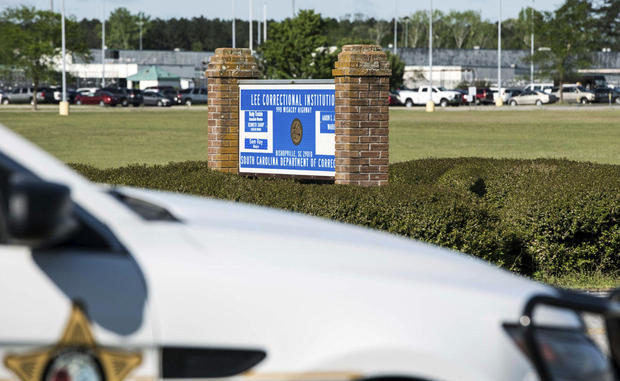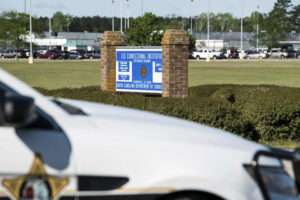
 COLUMBIA, S.C. — Prisoners armed with homemade knives rioted for more than seven hours inside a maximum-security facility, leaving seven inmates dead, and bodies were “literally stacked on top of each other,” an inmate told The Associated Press on Monday. At least 17 prisoners were seriously injured as inmates fought uninterrupted before authorities regained control of Lee Correctional Institution about 3 a.m. Monday, South Carolina prisons spokesman Jeff Taillon said.
COLUMBIA, S.C. — Prisoners armed with homemade knives rioted for more than seven hours inside a maximum-security facility, leaving seven inmates dead, and bodies were “literally stacked on top of each other,” an inmate told The Associated Press on Monday. At least 17 prisoners were seriously injured as inmates fought uninterrupted before authorities regained control of Lee Correctional Institution about 3 a.m. Monday, South Carolina prisons spokesman Jeff Taillon said.
The incident is being investigated by the South Carolina Law Enforcement Division. SLED and the corrections department were giving an update Monday afternoon.
Bryan Stirling, South Carolina corrections department director, said officials believe the riot was “all about territory, all about contraband” and cell phones at the prison, which houses some of the state’s worst and longest-serving offenders. No prison guards were hurt.
Stirling said gangs were fighting over territory and said cell phones help them continue criminal activity behind bars.
Responding to questions about the hours it took to secure the prison, Stirling said corrections officers are trained to back out of the dorm and call for support during disturbances. Officials said they “gathered a force that is safe” before sending officers into a dorm with 200-250 inmates.
Stirling said they entered and secured the first dorm around 11:30, and the second dorm at 12:30 a.m. They entered the final dorm around 2 a.m.
The prisoner who saw the riot exchanged messages with AP on the condition of anonymity because he is not allowed to have a cellphone and fears retribution from other inmates.
He also didn’t say what started the riot but said most of the inmates at the prison are affiliated with gangs and he saw several attackers taunt a rival gang member who was badly injured.
“I just saw three dead on the sidewalk outside of my unit. One guy is still alive and breathing, but just barely,” the inmate said.
Stirling confirmed that inmates put several others against a fence during the riot.
South Carolina governor Henry McMaster and Stirling called on the FCC for the blocking of cell phone signals to increase prison security.
“These are dangerous people… we cannot expect them to give up their dangerous ways just because they’re in prison,” McMaster said.
The riot was the latest violence in the South Carolina prisons system, where at least 13 other inmates have been killed by fellow prisoners since the start of 2017 and was the most inmates slain in a single riot in the U.S. since nine prisoners and a guard died in 1993 at the Southern Ohio Correctional Facility, said Steve Martin, a consultant who helps the federal government monitor prison systems.
250 prisoners were assaulted so severely in 2016 and 2017 they had to be treated in outside hospitals, according to public records obtained by The Post and Courier of Charleston. That was nearly double the rate from the two years before, the newspaper reported.
At Lee Correctional, an inmate held a guard hostage for 90 minutes in March and another killed a fellow prisoner in February.
The inmate who spoke to AP said that many cell door locks were already broken before the riot and that he and other prisoners roamed around freely. Hours after the violence started, no correctional officers or medical personnel attended to the dead or dying, he said.
“It’s been over two hours, but no COs (corrections officers) have responded to this unit, and no medical personnel have attempted to render any kind of aid,” he wrote. “The COs never even attempted to render aid, nor quell the disturbance. They just sat in the control bubble, called the issue in, then sat on their collective asses.”
South Carolina prison guards are not armed, so as long as employees aren’t threatened, they typically seal off wings when there is an inmate uprising and wait for a special team of state police to arrive to try to stop the rioting.
Most of the slain inmates were stabbed with homemade knives or slashed, while the remainder appeared to have been beaten, Lee County Coroner Larry Logan told AP.
“How else are you going to die in prison? They don’t have guns,” Logan said by phone as he went to a hospital to finish identifying the dead.
The injured inmates required medical attention outside the prison, which is located 40 miles east of Columbia.
The South Carolina Department of Corrections tweeted that the deaths happened in multiple inmate-on-inmate fights in three housing units. It began at around 7:15 p.m. Sunday. The prison was secured around 2:55 a.m. Monday, the corrections department told CBS affiliate WLTX.
Corrections officials on Monday identified the slain inmates as Raymond Angelo Scott, Michael Milledge, Damonte Marquez Rivera, Eddie Casey Jay Gaskins, Joshua Svwin Jenkins, Corey Scott, and Cornelius Quantral McClary.
The inmate told AP that he knew at least two of the slain men well. He said he saw an inmate trying to get up before he “started into that ‘death rattle’ people often hear about, but never experience firsthand.”
The slain were serving anywhere from 10 years to life in prison and their crimes ranged from murder to burglary to trafficking crack cocaine. They youngest was 28 years old while the oldest was 44.
The coroner said when he arrived it was a chaotic scene of fighting everywhere. Logan said the state-run Lee Correctional Institution, like most other South Carolina prisons, is struggling to find enough workers, but he doesn’t believe anything could be done once things got that far out of control.
“If everybody has an uprising, you are always going to be understaffed,” Logan said.
The maximum-security facility in Bishopville houses about 1,500 inmates. Two officers were stabbed there in 2015.
McMaster expressed support for state prisons chief Stirling.
McMaster spokesman Brian Symmes said the governor has “complete confidence” in Stirling’s ability to lead the state Department of Corrections.
